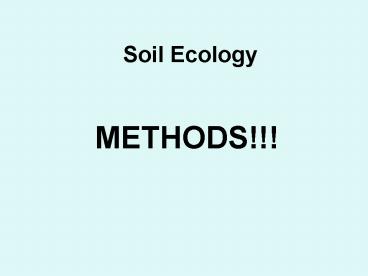Soil Ecology - PowerPoint PPT Presentation
1 / 29
Title:
Soil Ecology
Description:
Soil Ecology METHODS!!! * * * * RFLP- If two organisms differ in the distance between sites of cleavage of a particular restriction endonuclease, the length of the ... – PowerPoint PPT presentation
Number of Views:711
Avg rating:3.0/5.0
Title: Soil Ecology
1
Soil Ecology
- METHODS!!!
2
Sampling
- Statistical
- systematic
X X X X X X X X X
X X X X X X X X X
X X X X X X X X X
X X X X X X X X X
X X X X X X
42 samples
3
Sampling
- Statistical
- systematic
- random
X
X
X
X
X
X
X
3 samples representative??? or 14 samples
ok???
X
X
X
X
X
X
X
4
Sampling
- Statistical
- systematic,
- random,
- stratified random
X
X
X
X
X
X
X
X
11 samples better/???
X
X
X
5
Sampling
- Number of samples?
- ((t value2) x (sample variance)) /
- (sample mean - population mean)2
- May be able to afford to sample that many but may
not be able to afford to analyze large number of
samples ( for analysis/total samples). So? - Composite samples
6
SamplingWhat to sample????
- Bulk vs specific
- (eg average vs nonrhizosphere or rhizosphere
or - rhizoplane or .)
- Substrate
- (eg, forest floor, A horizon, decomposing wood,
etc)
7
Sampling
- Depth standardized between treatments!
- (some organisms found at specific depths due to
eg light, moisture, roots, .) - Time - organisms active, dead, nonactive
- (season, related to plant growth, time of day,
.) - Storage Transportation
- Soil cans, jars, paper bags, plastic
- Air dry, moist, wet, frozen, .
8
Methods of Soil Organisms in ESRM 409Form and
arrangement of microbes
- Direct
- Light microscopy
- contact (buried slide)
- nylon mesh
9
Methods of Soil Organisms Microbial species
biodiversity
- Direct
- microscopy
- Indirect
- Soil plates
- Dilution plates
- Root washing
- Isolation from plant tissue, eg
- Root fragmentation
- Surface sterilization
http//textbookofbacteriology.net/growth.html
10
Methods of Soil Organisms Microbial species
biodiversity
- Direct
- Indirect
- Genetics
- Restriction Fragment Length Polymorphism
(RFLP) - organisms may be differentiated by analysis of
patterns derived from cleavage of their DNA - and
- Polymerase chain reaction (PCR)
- easy method for generating unlimited copies of
any fragment of DNA
11
Microbial species biodiversity
- Restriction Fragment Length Polymorphism (RFLP)
- DNA fingerprinting
Unique bands
Common bands
Electrical current applied thru gel and gradient
formed of the different DNA strands (fluorescent
markers)
(Sylvia, Fuhrmann, Hartel, and Zuberer 2005)
12
Microbial species biodiversity
- Polymerase chain reaction (PCR)
http//www.faseb.org/opa/bloodsupply/pcr.html
13
Methods of Soil Organisms Microbial species
biodiversity
- Direct
- Indirect
- Genetics
- Functional biodiversity
- Biolog fungilog plates
14
Microbial species biodiversity
- Biolog fungilog plates
15
Methods of Soil Organisms Microbial s Biomass
- Counting - Extinction dilution
- Most Probable Number (MPN)
CFU colony forming units and the number of
cfu's is related to the viable number of bacteria
in the sample.
http//www.jlindquist.net/generalmicro/102dil1.htm
l
16
Most Probable Number
1st set
2nd set
3rd set
Goes to extinction
http//www.jlindquist.net/generalmicro/102dil3.htm
l
17
Most Probable Number
No. of Tubes Positive in No. of Tubes Positive in No. of Tubes Positive in MPN in theinoculum of themiddle set oftubes
firstset middleset lastset MPN in theinoculum of themiddle set oftubes
0 0 0 0.03
0 0 1 0.03
0 0 2 0.06
0 0 3 0.09
No. of Tubes Positive in No. of Tubes Positive in No. of Tubes Positive in MPN in theinoculum of themiddle set oftubes
firstset middleset lastset MPN in theinoculum of themiddle set oftubes
3 2 0 0.93
3 2 1 1.5
3 2 2 2.1
2 2 3 2.9
http//www.jlindquist.net/generalmicro/102dil3.htm
l
18
Most Probable Number
3-2-0 suggests an average of 0.93 organisms being
inoculated into each of the tubes of the middle
set (of the three sets of tubes chosen) i.e.,
those inoculated with one ml of a 103 dilution.
Therefore, the most-probable number of
organisms per one ml of the original, undiluted
sample would be 0.93 X 103 or 9.3 X 102 or 9,300
organisms/ml of sample.
http//www.jlindquist.net/generalmicro/102dil3.htm
l
You can then find average biomass numbers per
that type of organism and then multiply that
times the number of organisms.
19
Methods of Soil Organisms Microbial s Biomass
- Counting - Extinction dilution
- Most Probable Number (MPN)
- Cell and spore counts to biomass
- Microbial biomass
- Chloroform fumigation
20
Methods of Soil OrganismsInvertebrate s
Biomass
- Berlese-Tullgren Arthropod Extraction From Soil
and Litter
http//www.geog.uhttp//faculty-staff.ou.edu/K/Mic
hael.E.Kaspari-1/berlese.htm
21
ROOT SAMPLING Root excavation and
coring N-fixing nodules Mycorrhizae
22
Methods of Soil OrganismsDecomposition
- respiration
http//wvlc.uwaterloo.ca/biology447/modules/module
8/soil/chapter3Soil446.htmRespiration20measureme
nts
23
Methods of Soil OrganismsDecomposition
- Litterbags
http//www.geog.uu.nl/fg/gapsize/thesis-ovd/Deel10
20Hfd07.pdf
24
Methods of Soil OrganismsDecomposition
- Litterbags
- /or
- Shredders
- Eg Pill bugs in petri plate w/ leaves
http//www.geog.uu.nl/fg/gapsize/thesis-ovd/Deel10
20Hfd07.pdf
25
Methods of Soil Organismsrelated Ecosystem
parameters
- Temperature
Soil cans
- Moisture
- Rain gauges
26
Methods of Soil Organismsrelated Ecosystem
parameters
- Bulk density
Bulk density (dry g/cm3)
27
Methods of Soil Organismsrelated Ecosystem
parameters
Soil cans
Air-dry after return from field
2mm sieve
Balance
28
Methods of Soil Organismsrelated Ecosystem
parameters
Drying ovens (75C 105C) muffle furnace for OM
pH meter
29
Methods of Soil Organisms
- Sampling
- Direct
- Indirect
- Genetics
- Functional biodiversity
- Counting
- Microbial biomass
- Soil organism activity































